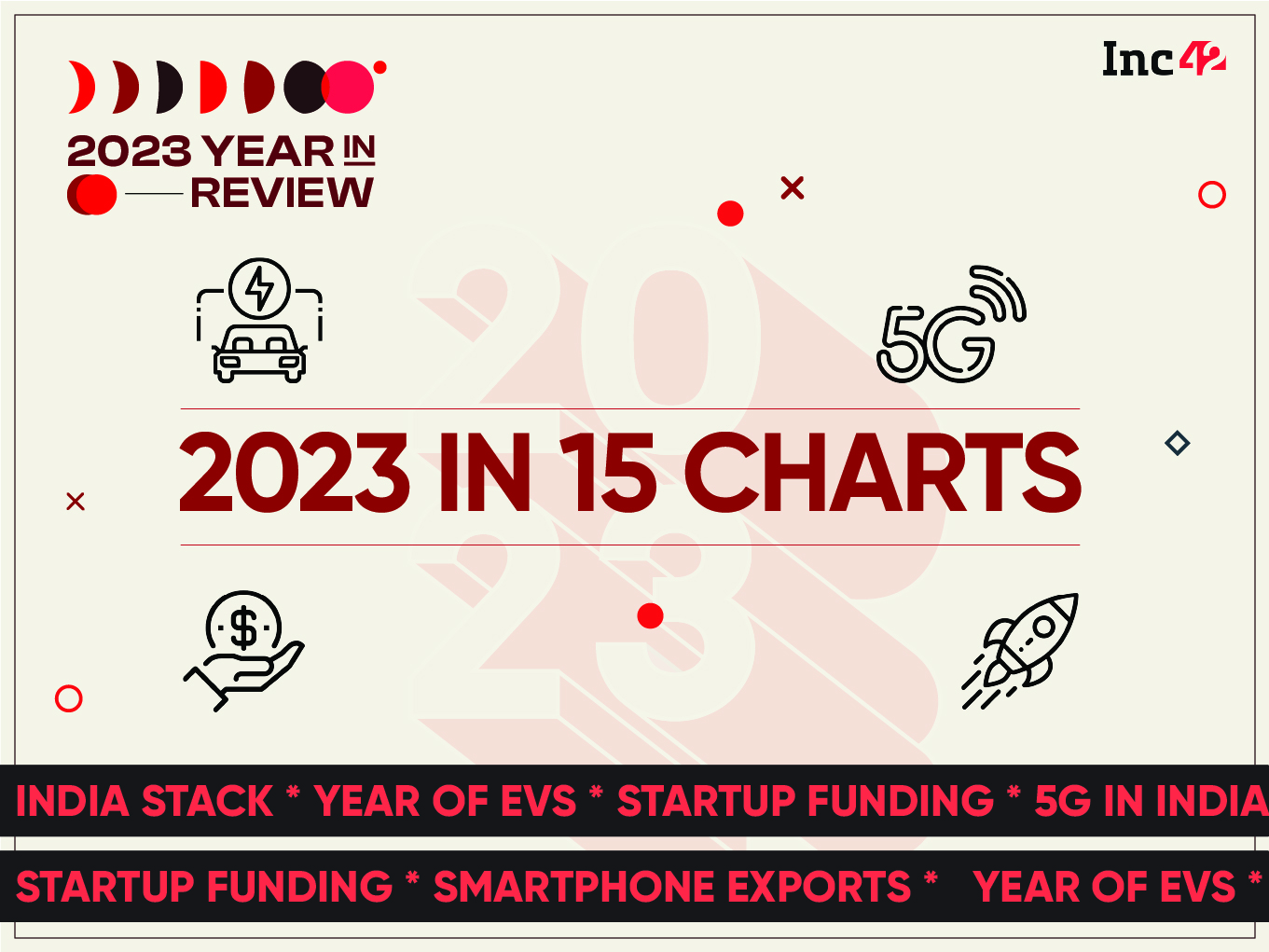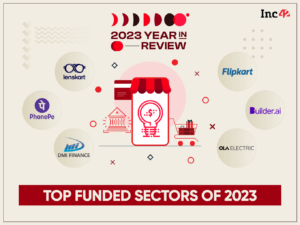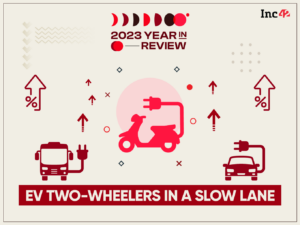SUMMARY
What better way to end the year than a look back at the macro trends that shaped Indian tech and startups this year. Here are the key visuals that capture the year gone by
We have covered the length and breadth of the Indian startup ecosystem in the past month. Our 2023 in Review series has recapped the controversies, startup success stories, the newsmakers in Indian tech, the public listings in 2023 and upcoming IPOs of Indian tech startups, and more.
And looking ahead at 2024, we have mapped out the trajectory of the key sectors through our Indian Tech Outlook series.
But there’s still some breath left in 2023 and what better way to encapsulate this year than 15 visuals that succinctly point out what the past 12 months have wrought on the Indian startup ecosystem.
Without further ado, here are the 15 charts that best capture 2023 from the point of view of Indian startups and tech ecosystem, starting with the key indicator — funding.
Startup Funding Plummets To Seven-Year Low In 2023
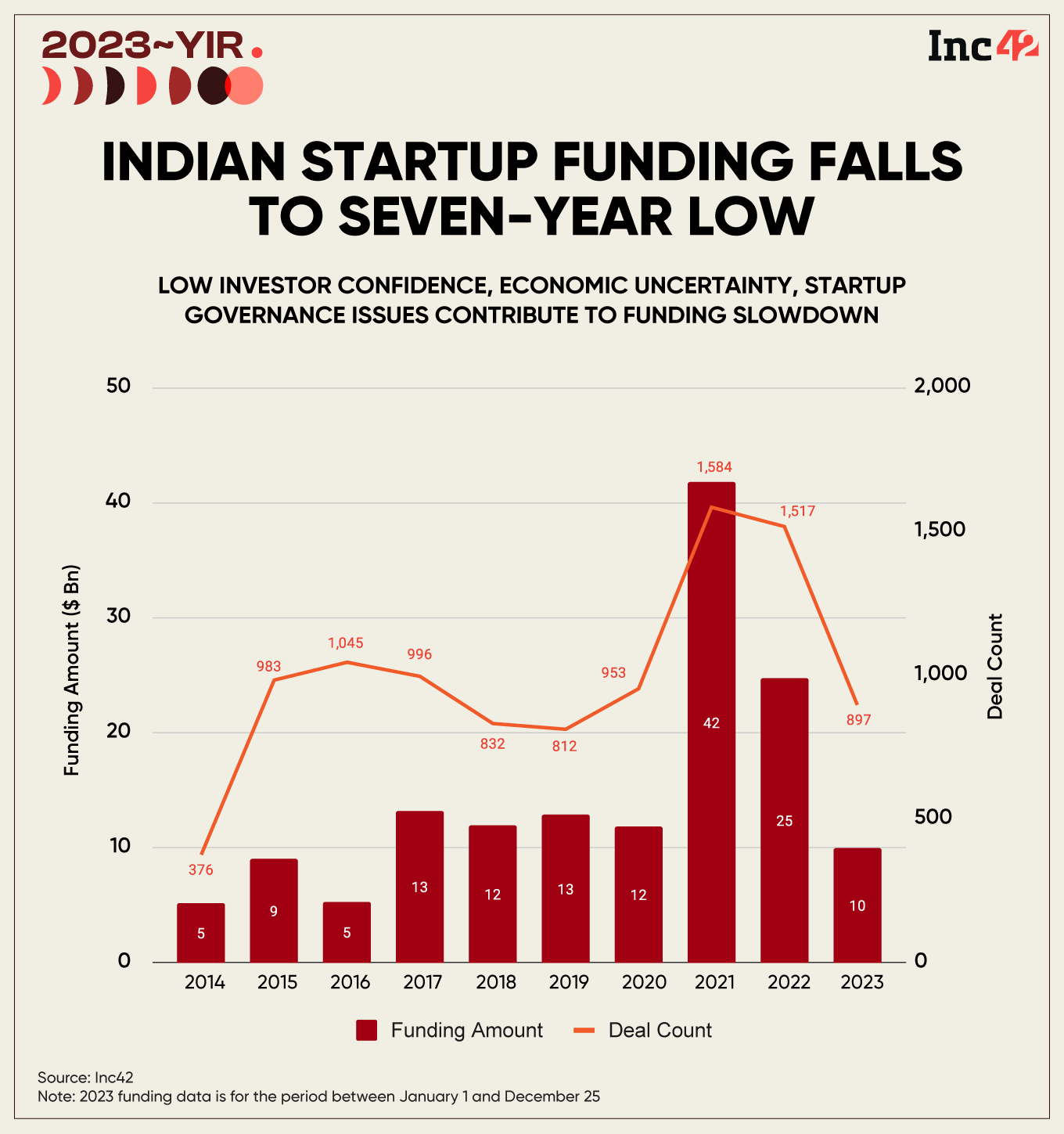
The year was 2023, but when it comes to startup funding, it might as well have been 2016. With just over $10 Bn raised in the year, the total funding inflow dropped to pre-2017 levels. What’s even more telling is that nearly $1 Bn of the total $10 Bn raised this year has come in December alone.
In fact, when we separate the outlier rounds (deals of $100 Mn and above), the total tally is $5.5 Bn, which is just over what the entire ecosystem raised in 2016. Indeed, as we will see, this decline in capital inflow has ripple effects in other areas of the ecosystem and indicates where the startup ecosystem is headed, particularly in new venture creation, startup valuations and more.
Pace Of New Venture Creation Cools Down
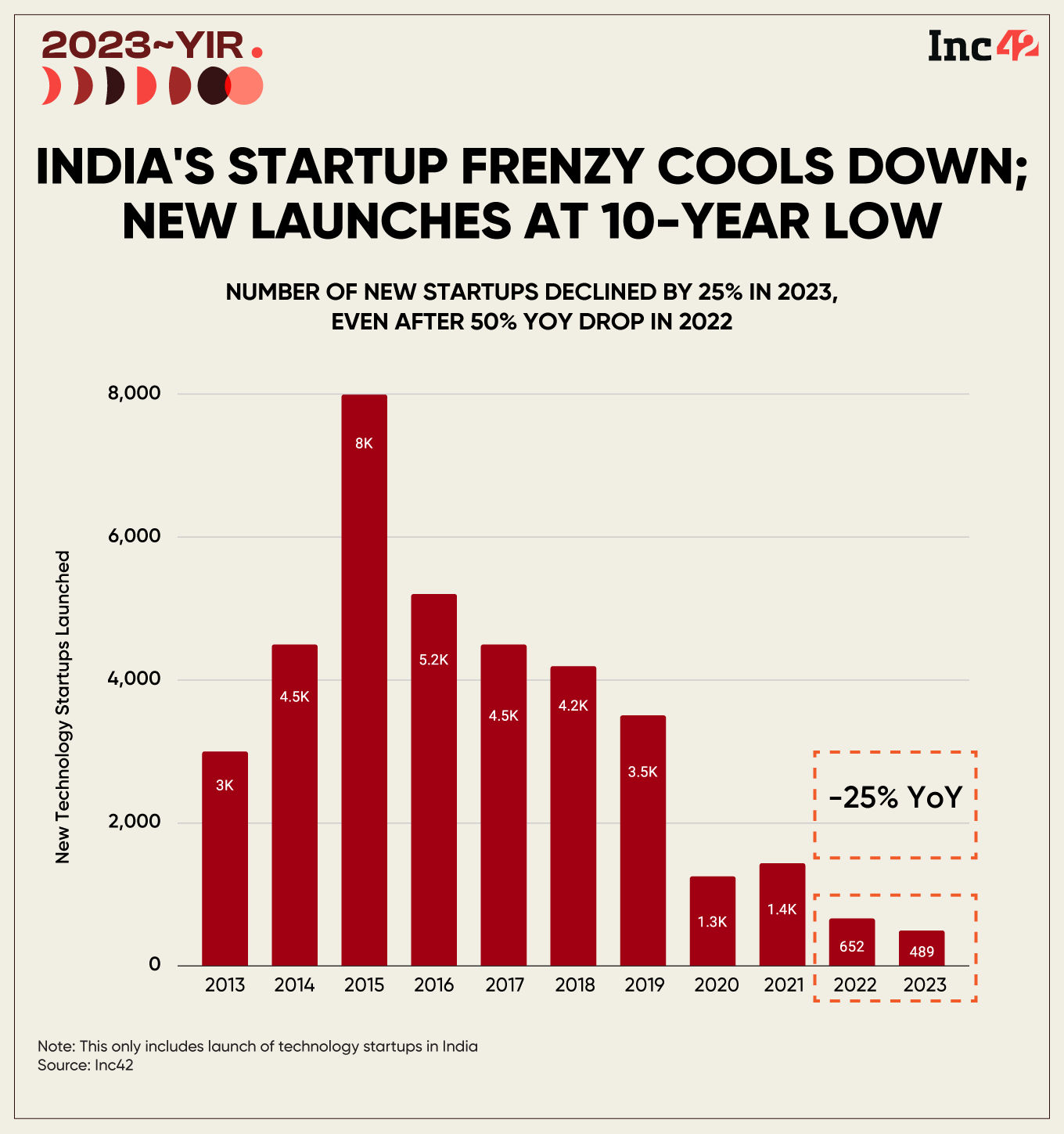
For a country which boasts 1.15 Lakh startups (as per DPIIT) and more than 68K tech startups, India has witnessed a major decline in new startups created over the last two years. This is despite several second-time entrepreneurs and CXOs launching new ventures in the past year, and the bullishness around early-stage funding.
The past two years combined saw 1.14K new startups coming into the, which is still quite a bit lower than the 1.4K new ventures that were recorded by Inc42 in 2021.
The factors that drove new business creation between 2019-2021 have faded into the background — that spurt came with the growing base of internet users and the fact that many founders looked to tap into newer segments of growth. In particular, we saw a surge in consumer brands and D2C startups, where there has been a paucity of new ventures in the past two years.
Another important factor was the so-called ‘Great Resignation’ in 2020 and 2021, which led to many new businesses coming into the picture. These startups looked to tap the digital transformation wave, but in 2023, some of these sectors — edtech, kirana tech in particular — have failed to live up to the hype of 2020-2021.
IPOs Show Recovery, But Startups Remain Cautious

Ten Indian tech startups went public in 2021, but 2022 saw the IPO enthusiasm fade away. In 2023, a brief window of opportunity opened up which saw five startups – ideaForge, Mamaearth, Yudiz, Zaggle and Yatra – going public between July and October.
While ideaForge saw the biggest pop on listing and listed at premium of over 90%, the other four IPOs received mixed to a muted response.
Public markets have not been too enthusiastic about loss-making tech IPOs in 2023, but the picture might change in 2024, with three companies — Ola Electric, Awfis and FirstCry — filing their pre-IPO documents with SEBI in December. Other major companies such as OYO, Digit Insurance and even Swiggy are expected to join the IPO parade in 2024.
By all indications, 2024 seems to be on course to change the IPO sentiments for tech startups, but these are still early days and a lot could change between now and the next few months.
Consolidation Wave Cools; M&As Back At 2019 Levels
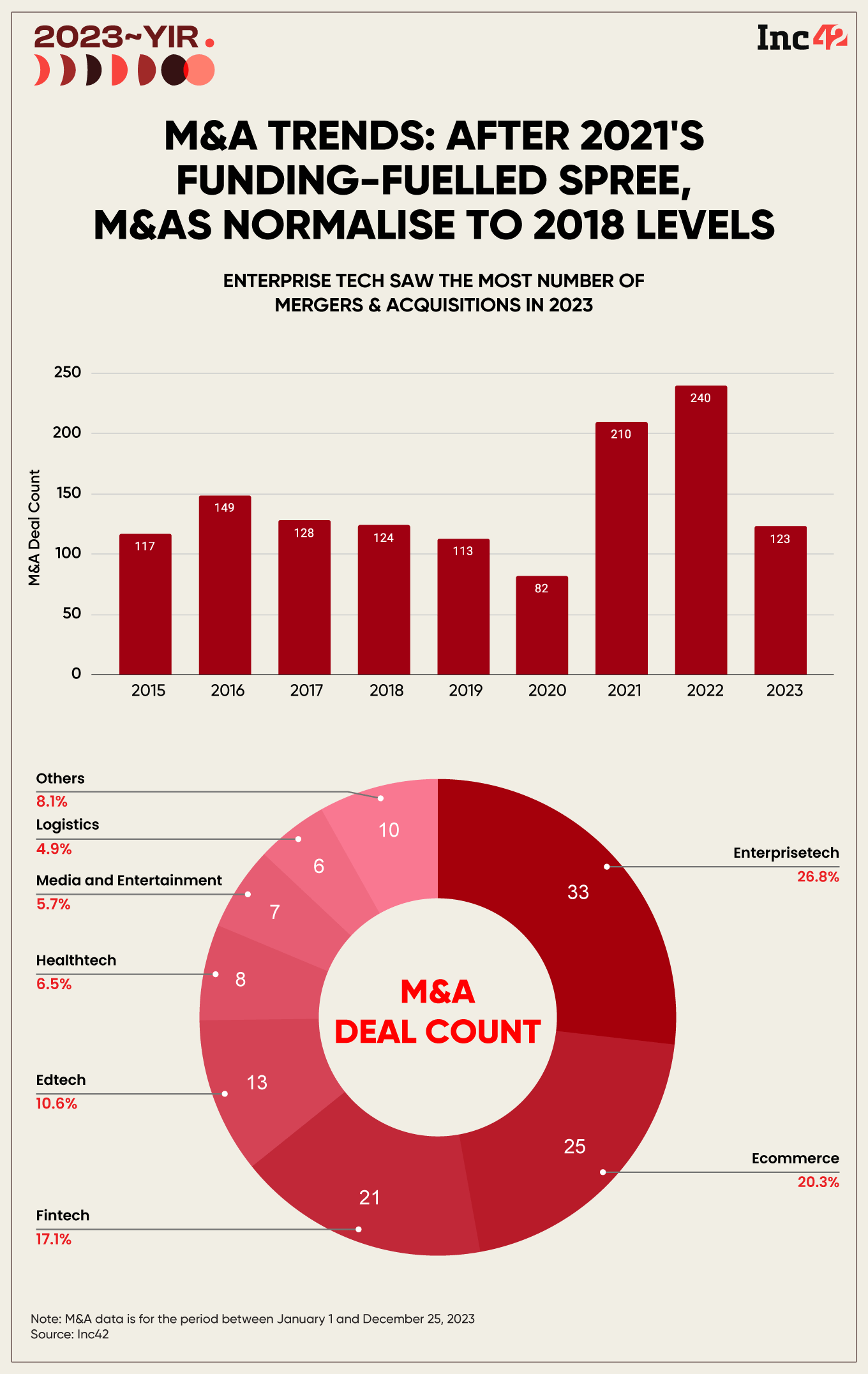
After the funding peak of 2021, startups went on an acquisition spree, which continued well into 2022 as startups splurged the capital raised for inorganic growth, product experiments and acquihires.
But 2023 has tempered the consolidation wave significantly. With just 112 mergers and acquisitions (M&As) this year, the tally is on par with 2019. As cash reserves fell in 2023, startups looked to cut costs and reduced hiring — many even shed parts of their businesses that they had so enthusiastically entered in 2021.
Plus, the relatively glacial flow of VC money meant that any consolidation had to be done through the cash generated by these businesses. Given that most startups are loss-making, only a handful could execute M&A deals. Many of these M&As have proven to be distressed sales, such as the Allen acquisition of Doubtnut or TenderCuts being acquired by Good To Go, or indeed the GoMechanic acquisition by Servizzy after the startup’s corporate governance debacle.
The situation is unlikely to improve in 2024 as many investors only expect the funding activity to pick up in the second half of the year, and even then, startups are likely to prioritise runway extension and revenue expenditure over luxuries such as acquisitions.
Investor Confidence Shakes In Women-Led Startups
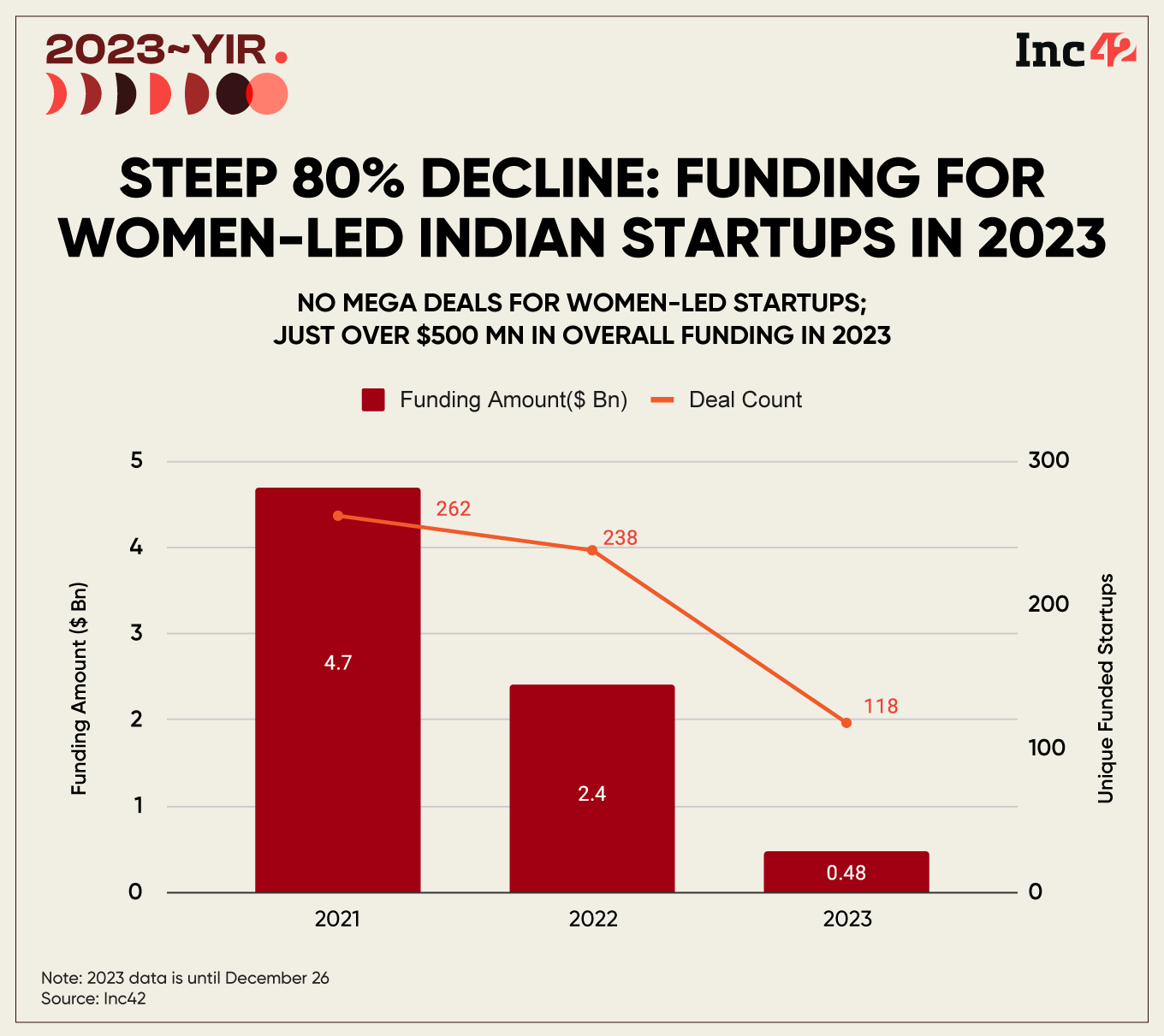
Towards the end of 2023, Smriti Irani, the Union Minister for Human Resource Development, accused VCs of bias towards startups led by men. “Risk-taking by VCs for women-led initiatives which are based on innovation is far lower as compared to those by men,” she had claimed
There is a grain of truth to this. Funding raised by women-led Indian startups has been declining since 2021, and 2023 was the worst in this regard, with the total funding tally for such startups not even accounting for 10% of the overall funding, unlike each of the three previous years.
So what changed in 2023? For one, there is some correlation between the decline in new venture creation and the fall in funding for women-led startups. It’s also noteworthy that newer areas of focus for the VC ecosystem in the past year are areas that are traditionally male-dominated — generative AI, manufacturing, new-age financial services and more.
In the past three years, ecommerce has emerged as the primary avenue for funding women-led startups in India, particularly evident in the direct-to-consumer (D2C) space. But D2C as a category has slowed down in 2023 and this also explains why there is a slowdown in VC funding for women-led startups unlike the pandemic era.
Investment Tech Boom Driven By Discount Brokers
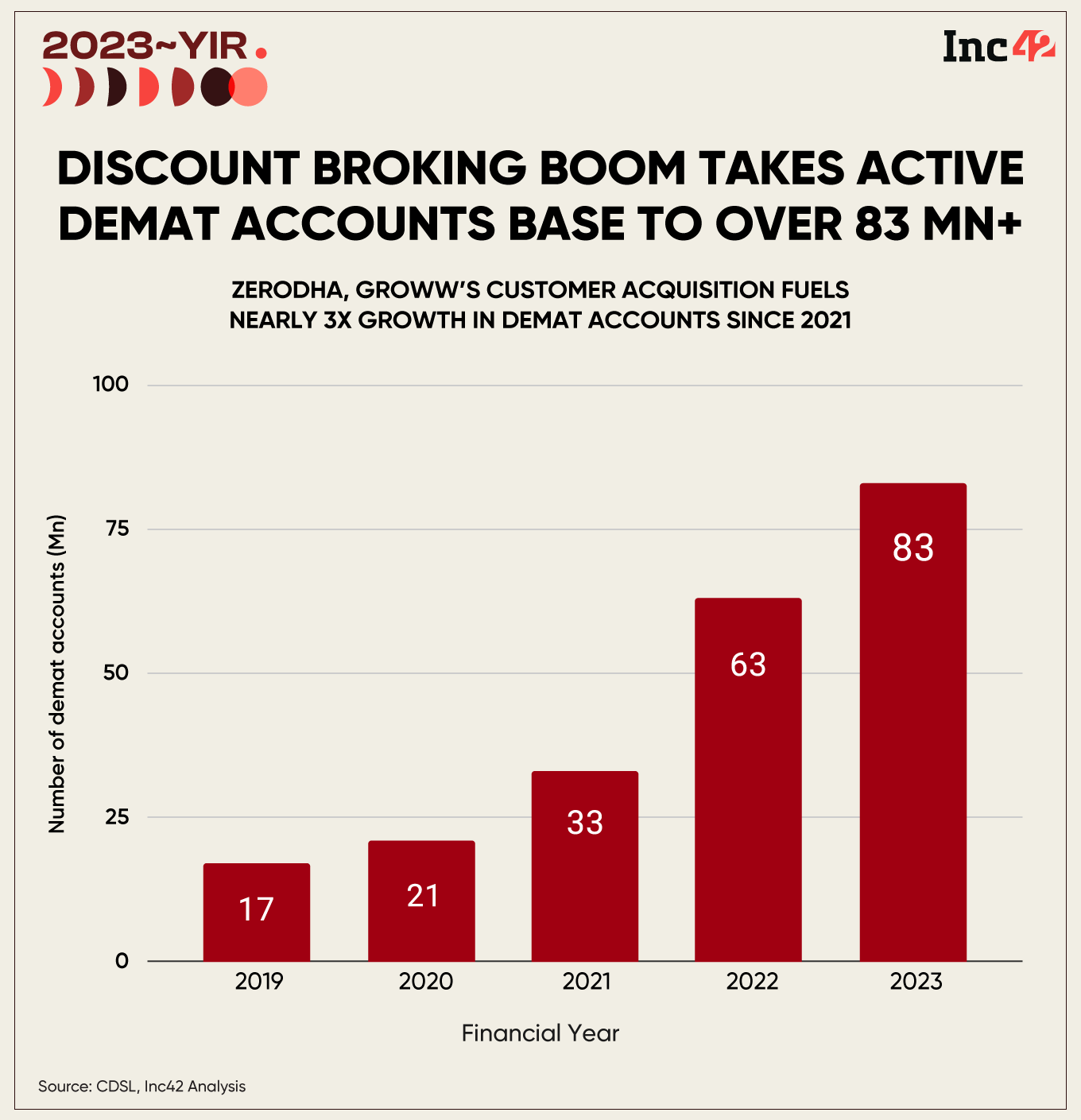
While the above graphic shows us steady growth in each fiscal year, it does not depict the actual surge in demat accounts in 2023 as a whole.
For context, the number of demat accounts in India rose to 127 Mn in August 2023, a YoY surge of 26%, primarily due to attractive returns from equity markets, and the ease of the account opening process.
What this growth indicates is the growing appetite for the Indian salaried class to invest in stock markets, mutual funds and other investment asset classes. Of course, a lot of the credit has to go for the government’s push for mutual funds investment through widespread promotional campaigns, but the role of discount brokerages such as Zerodha or Groww cannot be ignored.
Bengaluru-based Groww reached a new landmark with 6.63 Mn active investors on its platform at the end of September 2023, as against Zerodha’s 6.48 Mn. This made the company the biggest discount brokerage by clients in India. For context, Groww had 5.3 Mn active investors at the end of 2022, compared to Zerodha’s 6.3 Mn.
These platforms have leveraged technology to make onboarding much easier for new-to-market investors, introduced education initiatives to boost adoption and usage, and facilitated micro-investments in many asset classes, which has resulted in a major spike.
Credit Demand Surging Among Indians

The number of credit cards issued in India has seen a three-fold rise in the past five years, largely fuelled by digital customer acquisition, the launch of several co-branded credit cards and the role played by bank-fintech partnerships.
Credit (pun unintended) is also due to the card tokenisation policy that mandated ecommerce players to issue tokens for transactions instead of storing credit card details directly. This has eliminated some of the fears around card details getting leaked or hacked when stored improperly and pushed the usage of credit cards in India.
“As the country pushes towards a digital economy with an increasing volume of transactions, tokenisation has immense potential to further digitise the payment ecosystem. With a substantial 560 Mn tokens already in circulation and a fast-paced growth rate, we foresee tokenisation becoming a pivotal force in the evolution of digital payments,” RBI Executive Director P Vasudevan said in a report in November this year.
India’s Economy Bounces Back Strong After Post-Pandemic Cooldown
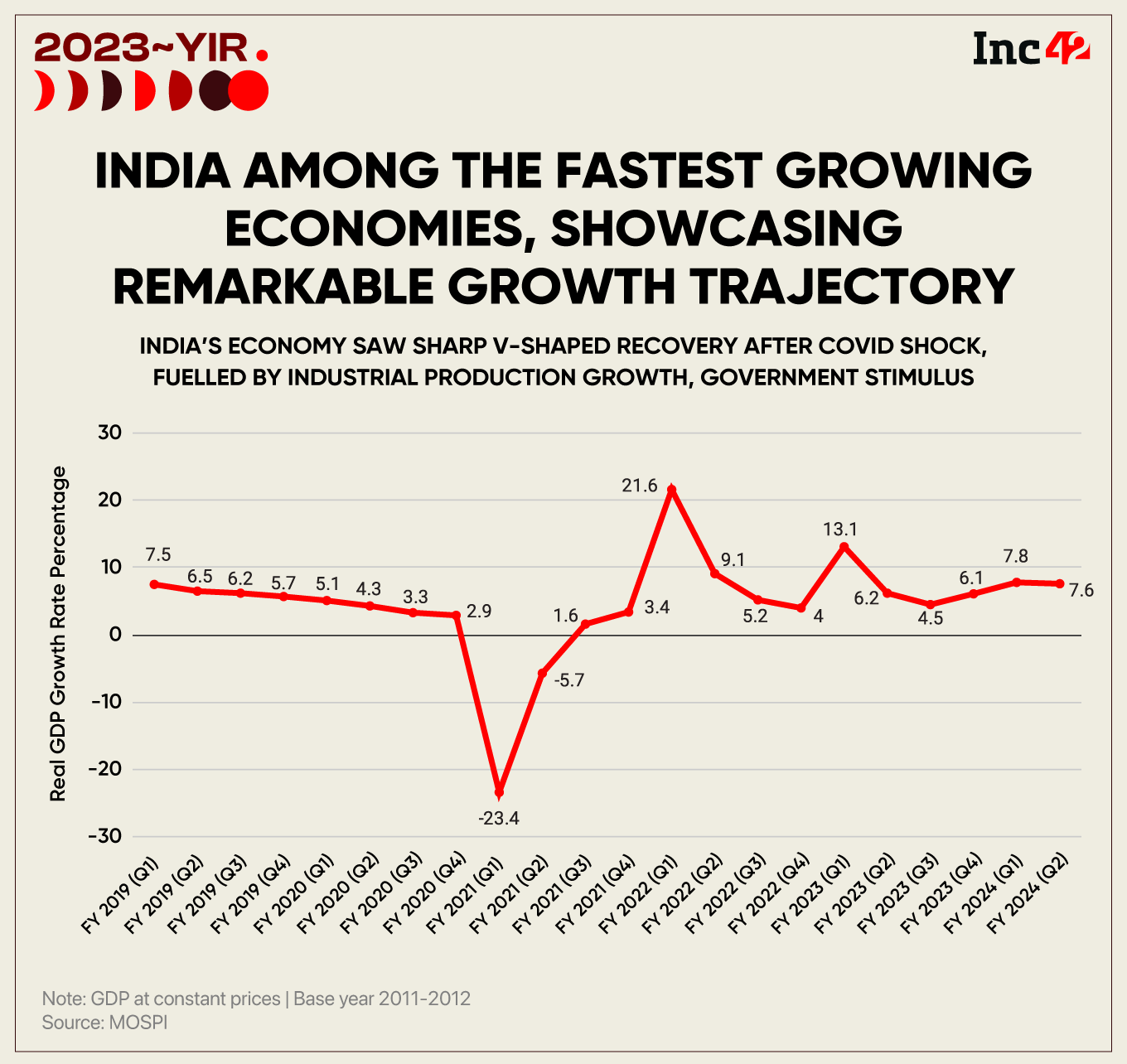
The pandemic brought the world to its knees, and India’s economy was not immune to the shock, but the revival since then has been cited as an example of sharp V-shaped recovery.
After nine successive quarters of degrowth till Q1 FY21, the Indian economy rebounded to become one of the fastest-growing economies in the world. The highlight was the incredible 21.6% growth during the first quarter of FY22, and since then we also saw a spike in Q1 FY23.
Even as major global economies showed recessionary signs in 2023, India’s economy remained robust, driven by government stimulus for industries such as manufacturing and a sharper focus on exports. This resulted in the industrial production index spiking, and electronics exports have contributed significantly to the growth (as seen below).
This is what the World Bank said about the Indian economy in October: “Despite significant global challenges, India was one of the fastest-growing major economies in FY23 at 7.2%. India’s growth rate was the second highest among G20 countries and almost twice the average for emerging market economies.”
FDI Inflows Fall Amid Global Pullback
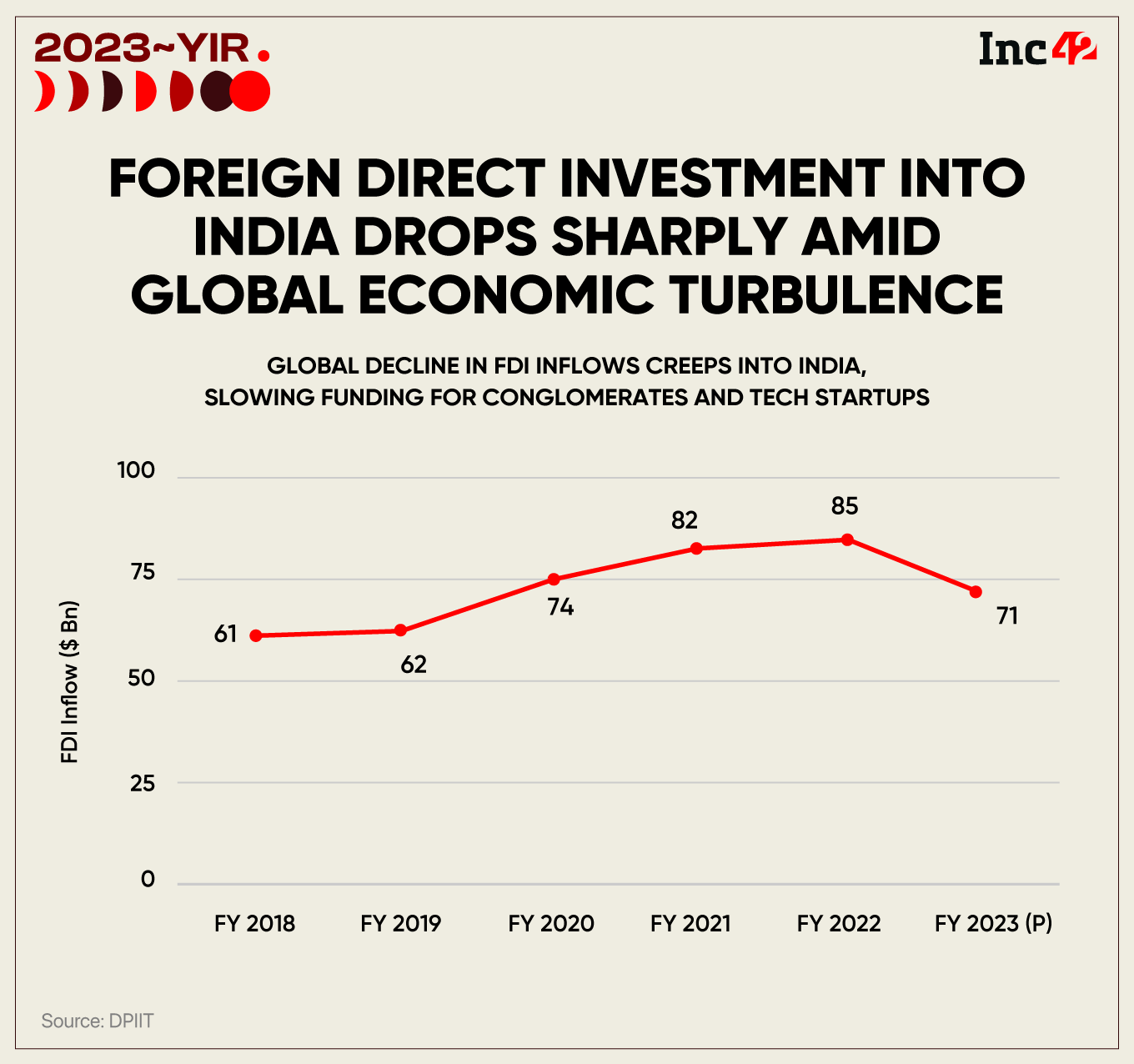
While the outlook remains positive for 2024, there are still some lingering concerns around FDI inflows, which have been a major contributor to the economic growth of the past two years.
But foreign direct investments are estimated to hover around FY20 level in FY23, which indicates that the global macroeconomic conditions have not stabilised as much as many might have hoped after the zero interest rate fiscal policies of many leading central banks around the world.
The Indian government has stated that production-linked Incentive (PLI) schemes for sectors such as electronics manufacturing, pharma, food processing, EV manufacturing, medical appliances and other areas have driven FDI. The China+1 movement could also be credited for FDI inflows remaining more or less consistent for India in the past two years.
But the outlook remains slightly bleak given geopolitical conflicts in the Middle East, Europe and the posturing of North Korea against the US in recent weeks.
These conflicts aside, there is high optimism among foreign investors in relation to the upcoming General Elections in India, with a widespread feeling of government stability. Will this help India mitigate any headwinds and gain from foreign investments as investors look to dodge the geopolitical tensions in other parts of the world?
Smartphone Exports Boom
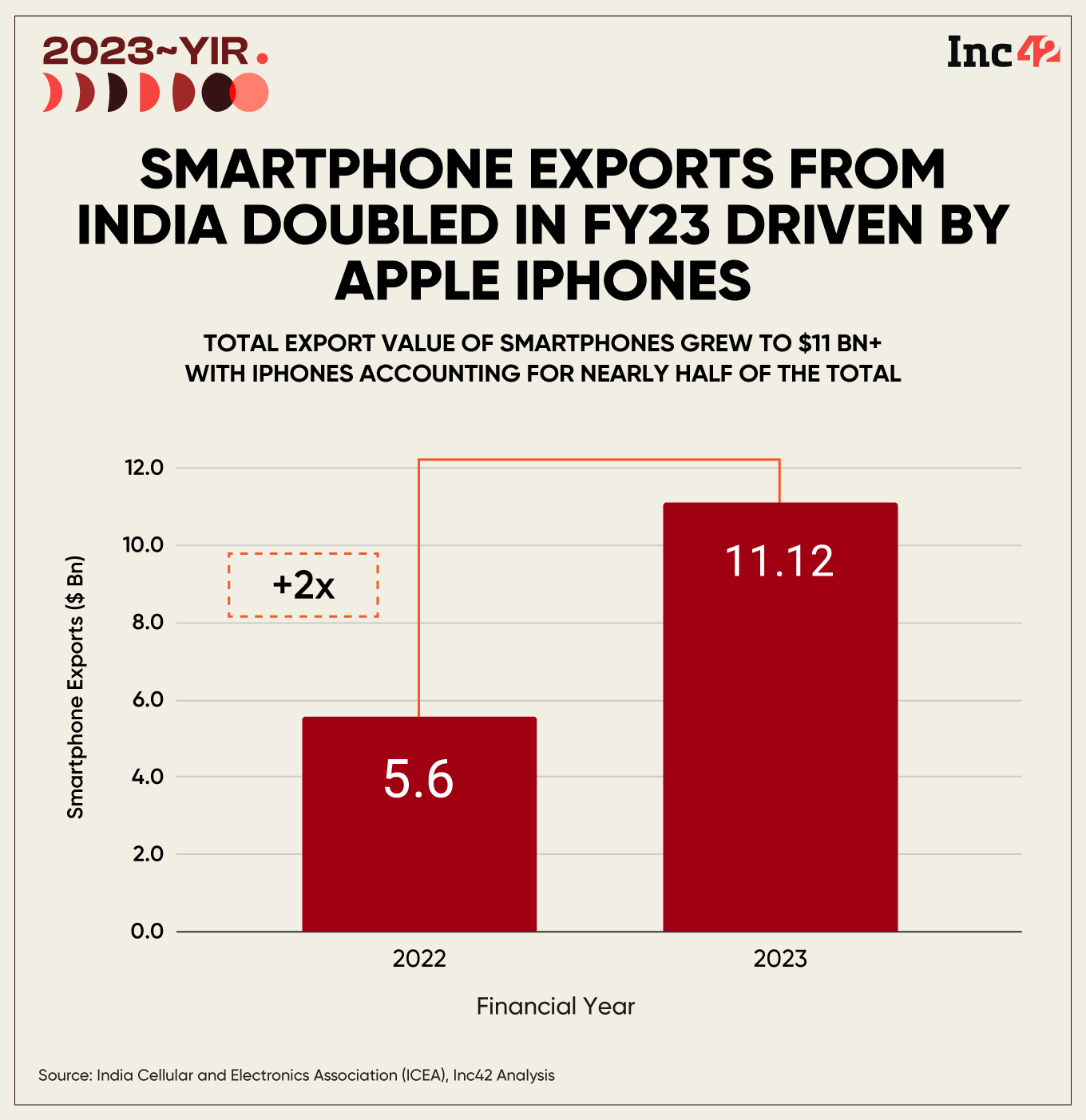
As we stated above, exports have been a central focus for India in the past two years and this is best reflected in smartphone exports from the country.
Morgan Stanley estimates that India’s smartphone market could triple in size by 2032, or reach $90 Bn in value as India becomes the third-largest economy in the world. But the wave of tech giants manufacturing in India has also become a dominant narrative in 2023.
The rapid growth in exports (nearly 2X higher in 2023) comes as a result of two factors – India’s PLI scheme for electronics manufacturing and Apple boosting its manufacturing in the country, which has also brought other major manufacturers to the Indian market.
According to government statistics from earlier this year, iPhone exports accounted for nearly 90% of the total value of smartphone exports from India. With Apple’s target of making India home to a quarter of its total manufacturing output, the country’s smartphone manufacturing segment is ready to make a bigger claim.
India’s Startup Ecosystem Is Now A Major Employer
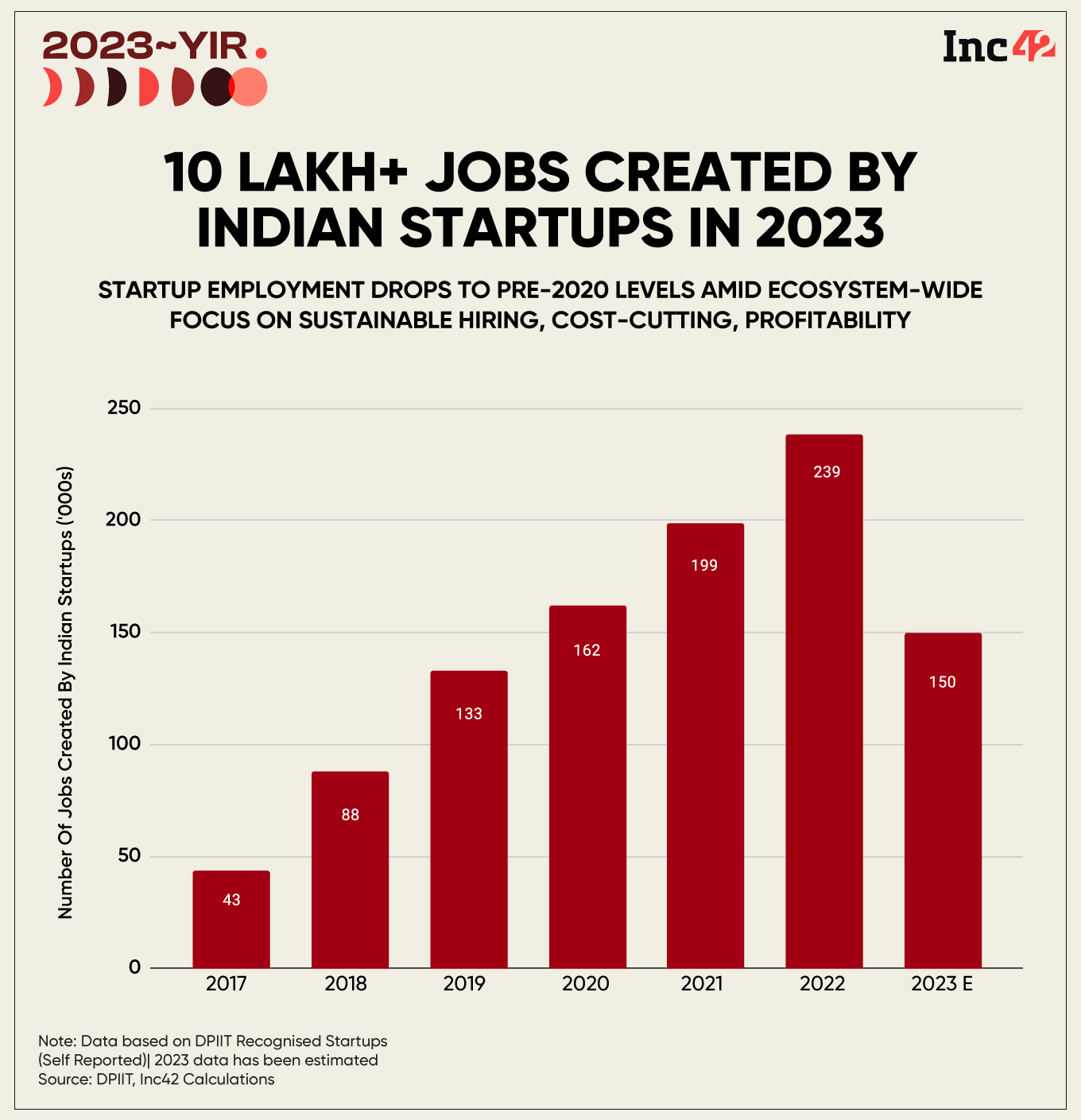
Over the past two years, job-related headlines from the startup ecosystem have been dominated by layoffs. While retrenchments have certainly plagued Indian startups, the ecosystem as a whole has also emerged as one of the biggest in terms of job creation.
Indian startups have created employment for more than 10 Lakh people over the past seven years, with several startups having created tens of thousands of jobs alone. Several factors have worked in favour of the trend observed.
The answer becomes much more obvious when superimposing the funding trends over employment generation, but as the number of startups itself rose rapidly, so did the employees being hired by them.
That said, 2023 saw a marked decline in funding and new startups being launched. The ripple effect of the latter would likely be felt over the next few years, as fewer companies opening now would lead to fewer job opportunities down the line.
The Breakout Year For Electric Vehicles
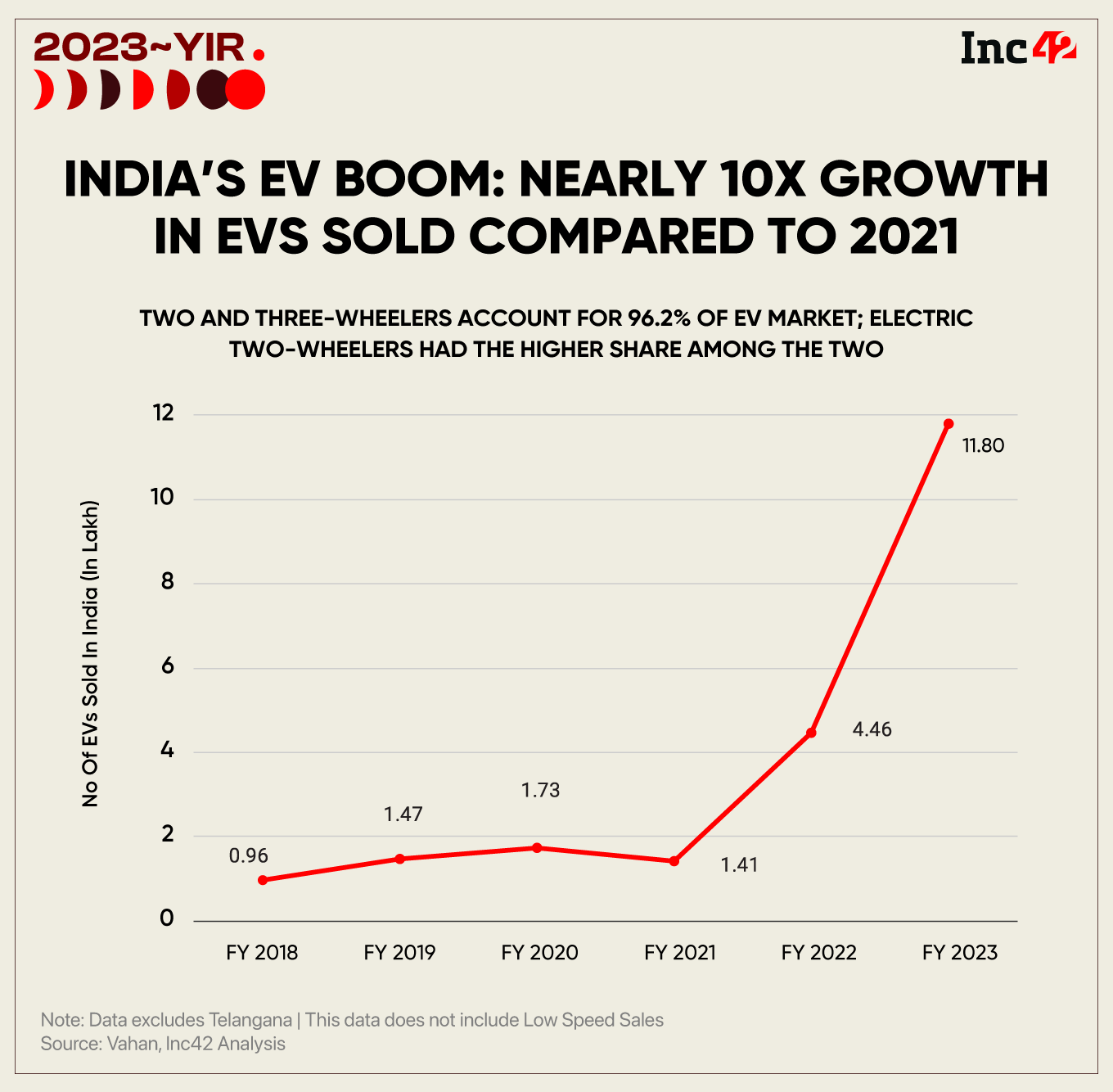
The enthusiasm around electric vehicles is best captured through the lens of Ola Electric. The company which only entered the OEM business in 2021 is on the verge of an IPO. It’s no wonder then that many observers are calling 2023 an inflection point for the electric mobility ecosystem
But we’d like to temper these expectations — India saw 5,60,240 EV registrations between April and November 2023, which indicates that FY24 is on track to record 8 Lakh registrations, much lower than FY23.
Several analysts have pointed out that EV sales boomed in 2023 due to substitutions of existing two-wheelers. Two-wheeler EVs dominated FY23 in terms of sales accounting for more than 49% of all registered EVs.
When it comes to the EV market, it’s firmly in the corner of two-wheelers, with the market share growing from 2.1% in FY2018 to 61.7% in FY2023. It’s as yet unclear whether OEMs can maintain this pace in the next couple of years. One factor that could spur EV sales and registration is the potential entry of EV giants such as Tesla, which would be a big signal for the transition from ICE vehicles to EVs.
Case in point: 70% of tier-one Indian car consumers state they’re willing to consider an electric car for their next vehicle, as compared to the record-high global average of 52%, per a McKinsey survey.
The likes of Tata, MG, Mahindra and others also have plans to bring more affordable four-wheelers to the market, which would undoubtedly also come with a boost for the EV charging infrastructure. So the big question is: Will 2024 be the year of electric cars?
UPI Breaches 100 Billion Mark
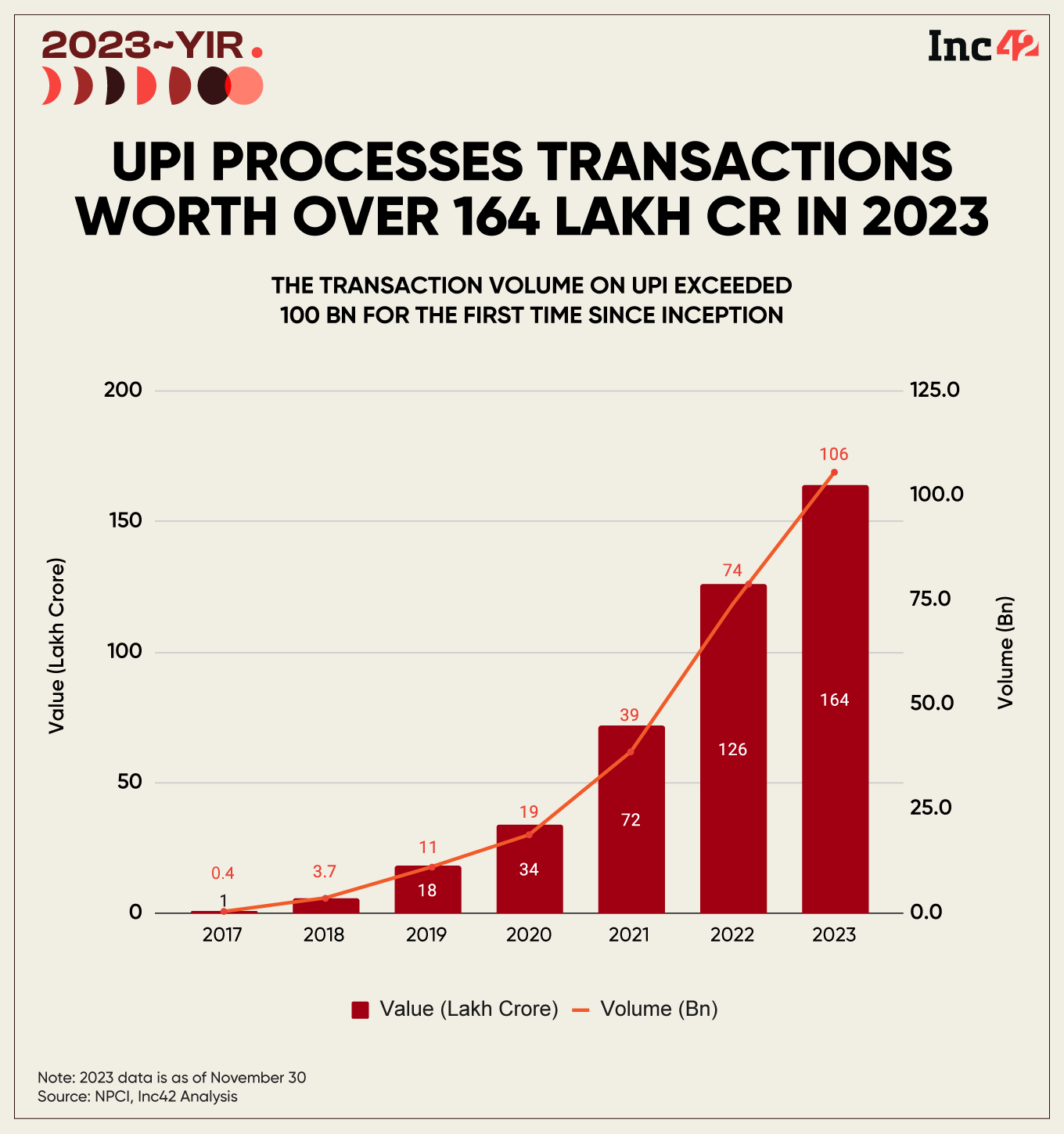
UPI — most fintech companies sing praises about it in public, while in private many are concerned about the over-reliance on UPI for payments, especially because it is a digital public good and therefore remains free for users to a large extent.
Despite the revenue downside, what is undeniable is that UPI has become a pillar of the digital economy, and has even crossed over to other geographies in the past two years.
In 2023, India saw more than 3,684 UPI transactions per second and 96% of this volume was driven by PhonePe, Google Pay or Paytm.
This year, CRED emerged as the darkhorse to shake up the competitive landscape, taking the total number of UPI transactions to well over 100 Bn in 2023. For context, this is 10X the transaction volume from just four years ago.
In many cases, UPI has become the key user acquisition channel for fintech startups and we do not foresee any slowdown in its usage, at least not until the Indian government introduces a merchant discount rate (MDR) for UPI transactions.
India In The 5G Era
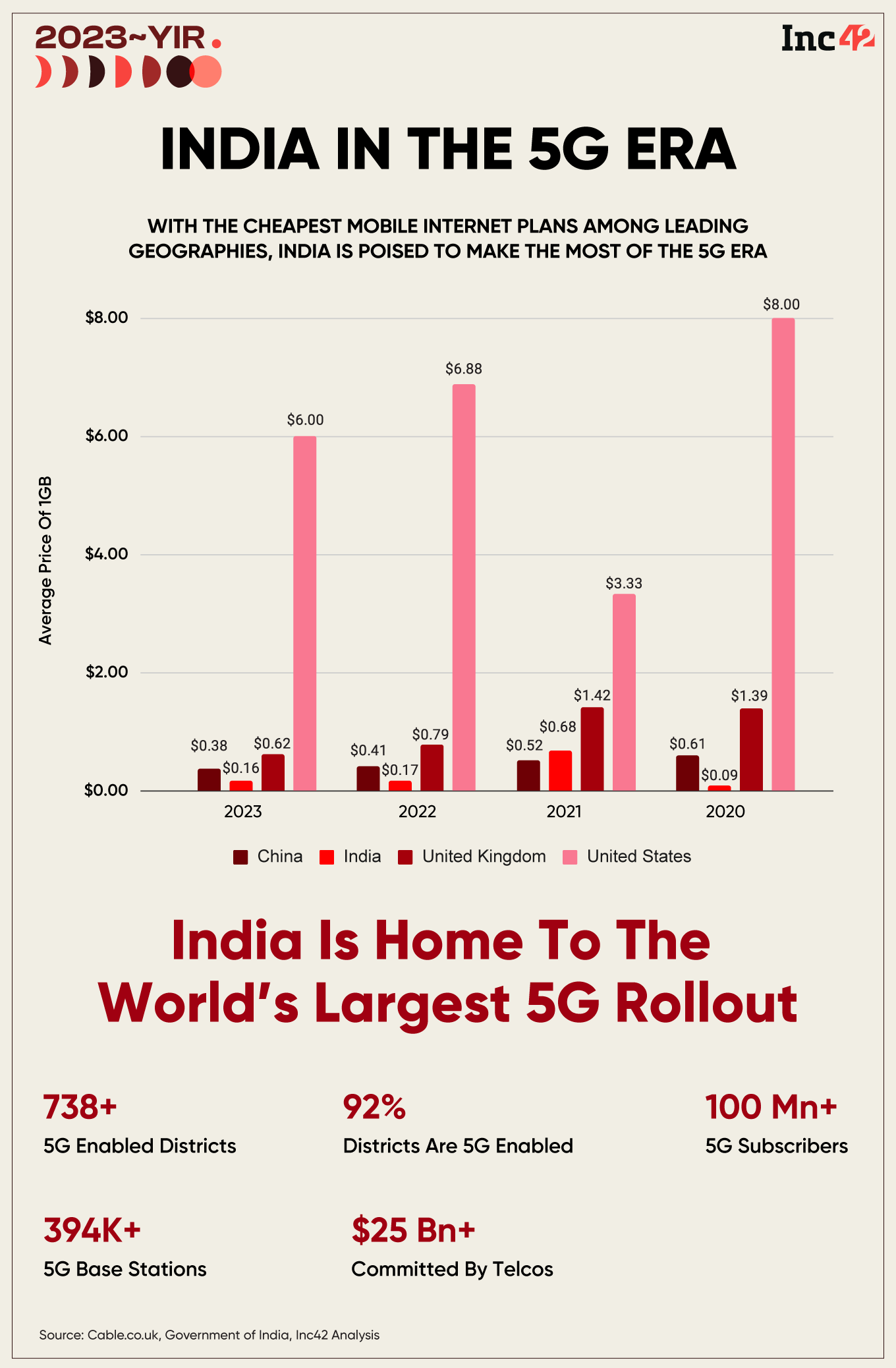
India’s mobile internet story has reached new highs every year since the introduction of 4G networks in 2015 and 2016. Reliance Jio’s blistering 4G launch in 2016 turbocharged India’s adventure into the internet age, as hundreds of millions of users went online with megabit speeds.
Seven years on, India’s telecom sector completed a 5G rollout that took less than two years between the 5G spectrum auction and 92% of Indian districts being 5G enabled.
Over the past few years, the Indian government has looked to push homegrown technology for the 5G era and today the telecom industry is widely regarded as one of the most important pillars of the economy, thanks to its widespread impact.
India’s push for self-sufficiency has resulted in India taking an early lead in 6G research, and as the industry becomes self-reliant, India’s telecom future looks secure.
Around a decade ago, when 2G was the norm in India, a GB of data would cost around INR 299, which was around $5. Fast forward to 2023, with nearly all of the country receiving 5G coverage, a GB of data costs less than 5% of what it used to in 2013.
The cheap internet has also fueled the rise of India’s digital economy – from UPI to food delivery, the affordability of the internet is fueling the $1 Tn digital economy India dreams of.
India Stack Built Around Digital Public Infrastructure

When innovation comes, regulation follows, but in India’s case, this is also backed by the rise of digital public infrastructure or DPI, where government-backed programmes and policies have driven adoption across fintech, education, banking, healthcare and other critical sectors.
Among these, UPI can be easily singled out as the most transformative digital innovation till date. Beyond this, if Aadhaar formed the backbone of India’s digital stack till a few years ago, the past few years have seen the rise of DigiLocker for identification and authentication of access to services, digital health IDs, technology-enhanced educational initiatives, the Account Aggregator (AA) framework and most recently the Open Network for Digital Commerce (ONDC).
The last of these promises to revamp not just ecommerce and delivery of consumer services, but is also eyeing a disruption of delivery and access to financial services.
India’s DPI progress is being seen as an example of how developing economies could propel their own tech ecosystems, with the government working closely with other nations to export this key pillar of the Indian economy in 2023.



